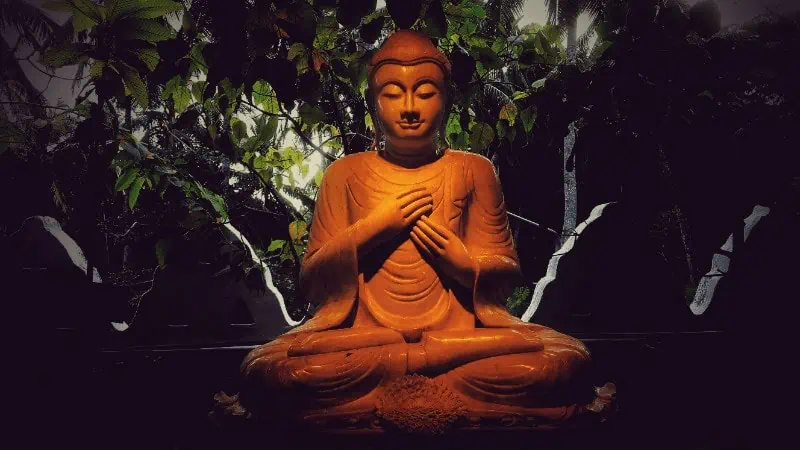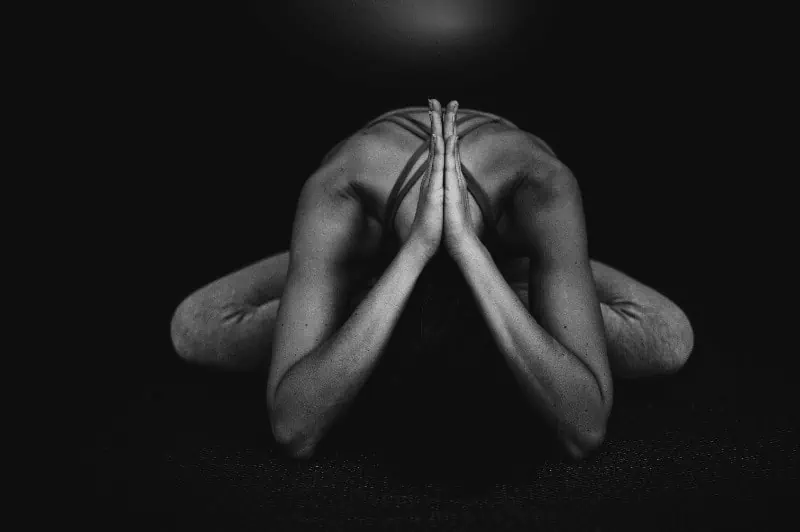When you hear the term Tantra yoga, do you think of a highly erotic sexual practice?
This is a common misconception of this ancient spiritual practice, but it couldn’t be further from the truth.
While sexuality is one aspect of it, tantra yoga is a platonic, spiritual, solo practice that features all the typical components of a traditional yoga class.
Whether you’re new to yoga or a seasoned practitioner, if you’re unsure what tantra yoga entails and want to learn more, this article is for you.
I’ll break down what traditional tantra yoga really is, why it’s commonly associated with sex, and how it compares to other yoga styles. And be sure to read until the end as I share what to expect from your first tantra yoga class.
Contents
- 1 Introduction to Tantra yoga
- 2 Differences between Tantric and Traditional Yoga
- 3 The Difference Between Tantra Yoga and Tantric Sex
- 4 The Encyclopedia of Yoga and Tantra
- 5 The Origins of Tantra Yoga
- 6 The Relevance of Tantra Today
- 7 Health Benefits of Tantra Yoga
- 8 Tantra Yoga Practice and Common Poses
- 9 FAQs
- 10 Final Thoughts
Introduction to Tantra yoga
Tantric yoga isn’t about sex; It’s a holistic practice encompassing meditation, pranayama (breathing exercises), and asana (physical postures).
The goal of tantra yoga isn’t to enhance sexual pleasure. This misconception occurs because, in tantra yoga, we use primal energy, including sexual energy, to connect with the divine.
To fully understand tantra yoga, let’s look at the word itself. Tantra derives from the Sanskrit root word tan, commonly translated as “to weave.”
How does this relate to tantric practice?
Well, classic tantric practices involve many techniques, including mantra chanting, breathwork, yoga poses, meditation, and energy work. The purpose is to weave all these practices together to unite the body, mind, and soul.
These tantric practices allow you to connect with your own energy (including sexual energy) to better understand yourself.
While the goal of traditional tantra was to attain enlightenment, many modern tantric yogic practitioners use this practice as a way to cultivate self-love and deepen their relationship with themselves and others.
Differences between Tantric and Traditional Yoga

Traditional yoga and tantra are both about attaining enlightenment, but the way you do it differs between both practices.
Traditional yoga involves following a disciplined path known as the eight limbs of yoga. Through this path, the goal of yoga is to overcome the ego and connect with the divine. Patanjali states in the yoga sutras that the purpose of yoga is the “cessation of the fluctuations of the mind,” in other words, bringing the mind into total stillness and tranquility.
Meanwhile, in tantra teachings, the divine energy is believed to be within us. As a result, tantra is about seeking liberation through connection to ourselves, while traditional yoga is about freedom through connection to a higher power.
Personally, I find tantric yoga to be more spiritual than traditional yoga. This is because it includes many rituals and is more focused on meditation and energy work than the physical poses.
Traditional tantra teaches that energy flow promotes spiritual growth, so the spiritual practices in tantric yoga emphasize the flow of energy within us. Through it, we seek to foster an awareness of the sacred energy flowing within us and deepen our connection to this energy.
Another key difference between yoga and tantra is their view on sexual energy. In short, yoga is about suppressing sexual energy, while tantra is about utilizing it. In the next section, we will explore this topic in more detail.
If you’re interested in learning more about the differences between classical tantra and yoga, there are many awesome books on this subject. I recommend Tantra: The Supreme Understanding by the widely known Indian philosopher Osho – this is the book I personally read during my yoga teacher training course.
The Difference Between Tantra Yoga and Tantric Sex

Tantric yoga and tantric sex are two different spiritual practices, but both branch from the classical tantra teachings.
Tantric yoga (what we’re discussing in this article) is commonly known as white tantra. It is a solo practice that involves physical poses, meditation, and other techniques.
Tantric sex (or sexual yoga) is known as red tantra and is practiced with a partner. It focuses on enhancing sexual pleasure and intimacy between partners and involves:
- Prolonging sexual activity
- Harnessing sexual fluids
- Deepening emotional connection
The ultimate goal here isn’t necessarily self-realization but heightened experiences during sexual practice.
In short, tantric yoga is about connecting deeper to yourself, while tantric sex is about deepening your connection to your partner.
In white tantra:
- You connect with your true self through meditation.
- You honor the divine nature within you.
In red tantra:
- You foster deep connections with your partner through shared experiences.
- You enhance intimacy by focusing on mutual satisfaction over individual gratification.

The Encyclopedia of Yoga and Tantra
See latest priceThe Origins of Tantra Yoga

Like other traditional yoga styles, Tantra is an ancient practice dating back thousands of years. While the earliest Tantric texts date back to the 5th to 9th centuries CE, some scholars believe Tantra has been around since the pre-Vedic period.
Tantra emerged in India, where it traditionally had strong connections with Shaivism and Shaktism.
Traditional tantra yoga emphasizes the integration of opposites through the union of Shiva (the male energy) and Shakti (the female energy). This symbolizes the union of individual consciousness with the divine consciousness.
Along with Hinduism, Tantra has origins and significance in Buddhist philosophy.
Buddhism and Tantra share several of the same concepts and practices; in fact, Tantra borrows heavily from Buddhist teachings and integrates many Buddhist principles into its practice, such as:
- Mindfulness
- Compassion
- Liberation from suffering
Moreover, mantras and yantras play vital roles in both Vajrayana Buddhism and tantra yoga, serving as tools for meditation and focus. Mantras are phrases or sounds chanted during meditation, and yantras are intricate designs like mandalas used as visual aids for concentration.
The Relevance of Tantra Today

While the traditional tantra practitioner sought enlightenment, in modern day life, yogis practice tantra yoga to cultivate self-love and compassion.
Moreover, because of its focus on enhancing connection, attending tantra yoga classes can help you foster healthier and deeper relationships. Partner tantra yoga classes, in particular, feature intimacy exercises that help couples better communicate and understand each other’s needs by promoting active listening, empathetic response, and open dialogue.
Of course, regular tantric yoga practice will also bring you many of the same benefits of Hatha yoga, which we’ll explore in the next section.
Health Benefits of Tantra Yoga
Tantra provides many spiritual and energetic benefits, yet it can also boost our health and well-being. Here’s how:
- Stress Reduction – Tantra is an effective stress management tool in our fast-paced, modern life. It offers mindfulness and meditation techniques to calm the mind, balance emotions, and foster inner peace.
- Physical Strength and Flexibility – While tantric yoga is not a fitness regime at all, it does include asanas (poses). These range from gentle stretches to challenging balances, helping you become stronger and more mobile.
- Immunity Boost – Tantra encompasses more deep breathing exercises than traditional yoga, which have been scientifically proven to boost the functioning of the immune system. This is because deep inhales increase oxygen flow, while full exhales help expel toxins from the body.
- Enhanced Sexual Wellness – Tantra focuses on harnessing sexual energy, which, in turn, promotes healthy sexual function and increased pleasure. There is much scientific evidence to back up the benefits of both male and female sexual wellness.
Tantra Yoga Practice and Common Poses

So, now you have a deeper understanding of the purpose and benefits of Tantra, you’re surely wondering what tantric practice involves.
While some styles of yoga, such as Bikram and Ashtanga, follow set sequences of asanas, this is not the case in tantric practice.
In fact, tantric yoga is more about the approach than the poses themselves. Therefore, tantra yoga classes are not always the same; they differ based on the style of the specific tantra yoga teacher.
However, one similarity you will find in tantra yoga is the emphasis on breath control. The teacher will likely emphasize the importance of deep and rhythmic breathing while executing each pose.
Visualization plays a vital role in tantra yoga, too. As you twist your body into different shapes, you’ll be encouraged to visualize the energy flow within you via the chakras. For example, you might visualize a rush of energy around your heart chakra while holding a backbend like the camel pose.
Tantra Yoga Poses
While there is no set asana sequence, here are some popular poses you might practice in a tantra yoga class:
Tantra yoga classes do not involve dynamic or flowing sequences like in Vinyasa Yoga. In general, you will hold static poses. However, if you combine the pose with breathwork, you might make slow and intentional movements to awaken and channel energy.
The Components of a Tantra Yoga Class
Along with asana, you will practice a range of different spiritual practices in a tantra class, including:
- Mudras – You might begin the session holding a particular mudra (sacred hand gesture) to evoke a certain energy, direct energy flow to a specific body part, or connect to a deity. Two common ones are Chin Mudra (thumb and forefinger touching) and Yoni Mudra.
- Bandhas – In tantra Yoga, you work with the bandhas (energetic locks) to control the energy flow within your body. The three primary bandhas are Mula Bandha (root lock), Uddiyana Bandha (abdominal lock), and Jalandhara Bandha (throat lock).
- Sensory Exploration – Some tantra classes also incorporate sensory experiences like exploring touch, taste, smell, and sound. This technique heightens your awareness, enhances mindfulness, and prepares the mind for meditation.
- Mantras – One type of meditation in tantra yoga is mantra meditation. This involves repeating a sacred word or phrase to cultivate focus and calm.
- Chakra activation – Another common mediation technique is visualization, where you visualize energy flow in the chakras to release blockages and stagnation. One common Chakra activation technique in Tantra is to awaken the dormant kundalini energy in the root chakra and encourage it to rise up the spine.
FAQs
What is Tantra Yoga?
Despite its reputation, Tantra yoga isn’t all about sex. Instead, it is a holistic practice combining meditation, breathwork, and movement to foster spiritual growth and inner connection.
What is the main goal of Tantra Yoga?
The primary aim of Tantra Yoga is self-realization – understanding and connecting to the divine energy within you, which is your true nature.
How Does Tantra Yoga Work?
Tantra yoga works by balancing your energies. It encourages harnessing sexual energy, among others – however, this is not for pleasure alone but for personal transformation.
Is Tantra Yoga Suitable for Beginners?
Absolutely! Tantra yoga suits everyone regardless of experience level. Start slow with basic poses, then gradually move on to more complex ones.
Can I incorporate elements of tantra into my existing yoga routine?
Definitely! Incorporating elements from Tantra, like deep breathing or chakra visualization techniques, can deepen your existing yoga practice while adding additional spiritual elements.
What are the Benefits of Practicing Tantra Yoga?
Practicing tantra yoga offers numerous benefits, including:
- Enhanced self-awareness and self-love
- Improved relationships with others
- Increased vitality
- Reduced stress
Final Thoughts
While it is commonly known as sexual yoga, Tantra is much more than cultivating a sense of pleasure. Tantra yoga is a solo practice similar to other styles of yoga in terms of techniques. However, its focus differs from traditional yoga, emphasizing connecting with yourself and the divine with you.
So, whether you want to bring more self-care into your life, connect to your sacred sexuality, or communicate better with your partner, why not give Tantra yoga a go and experience the benefits in your own life?


